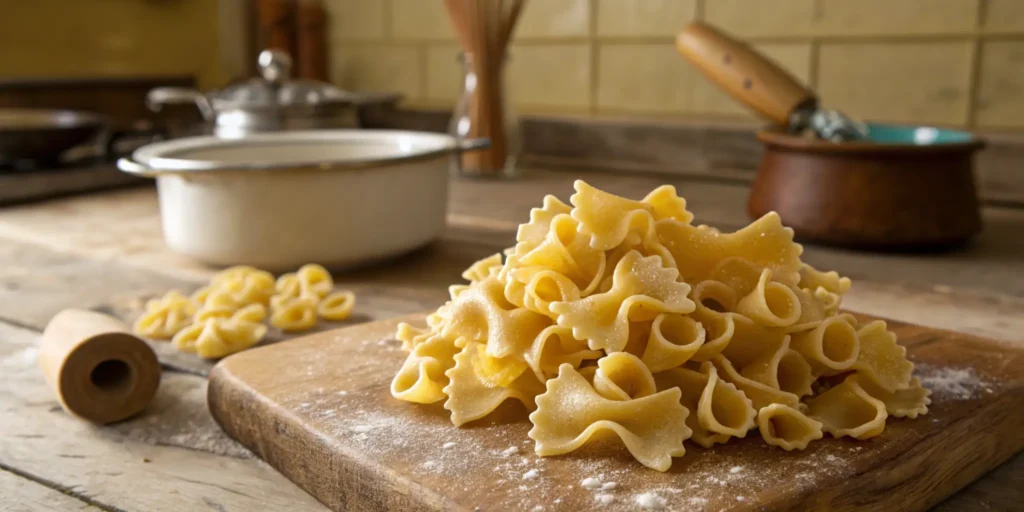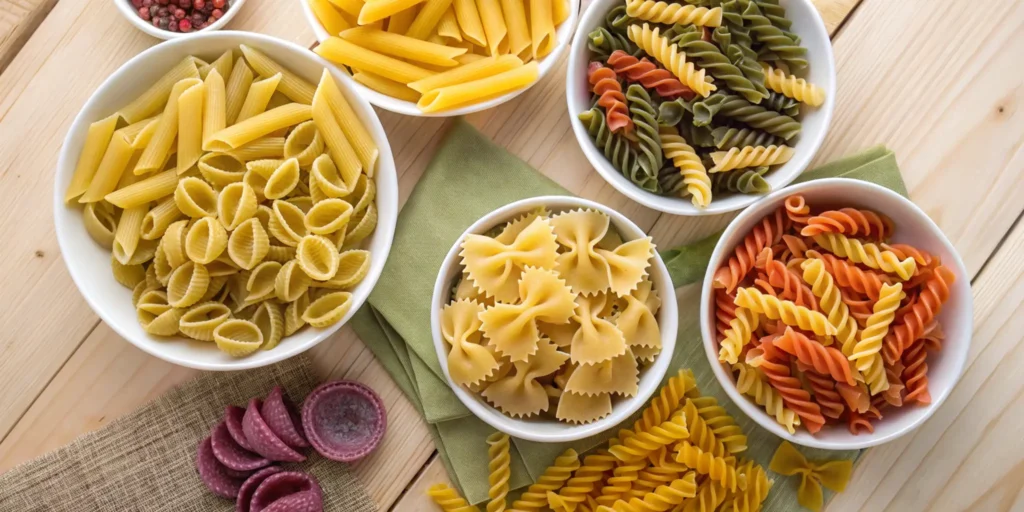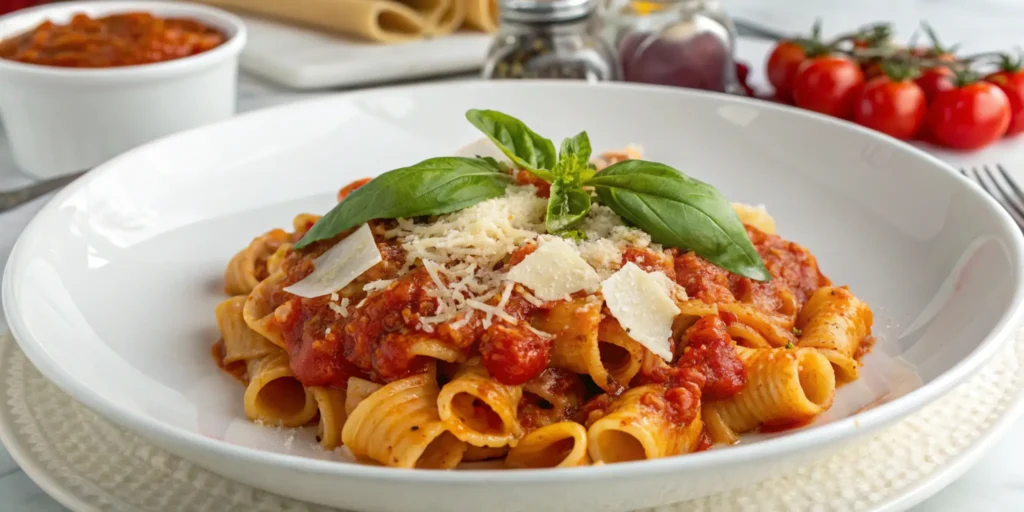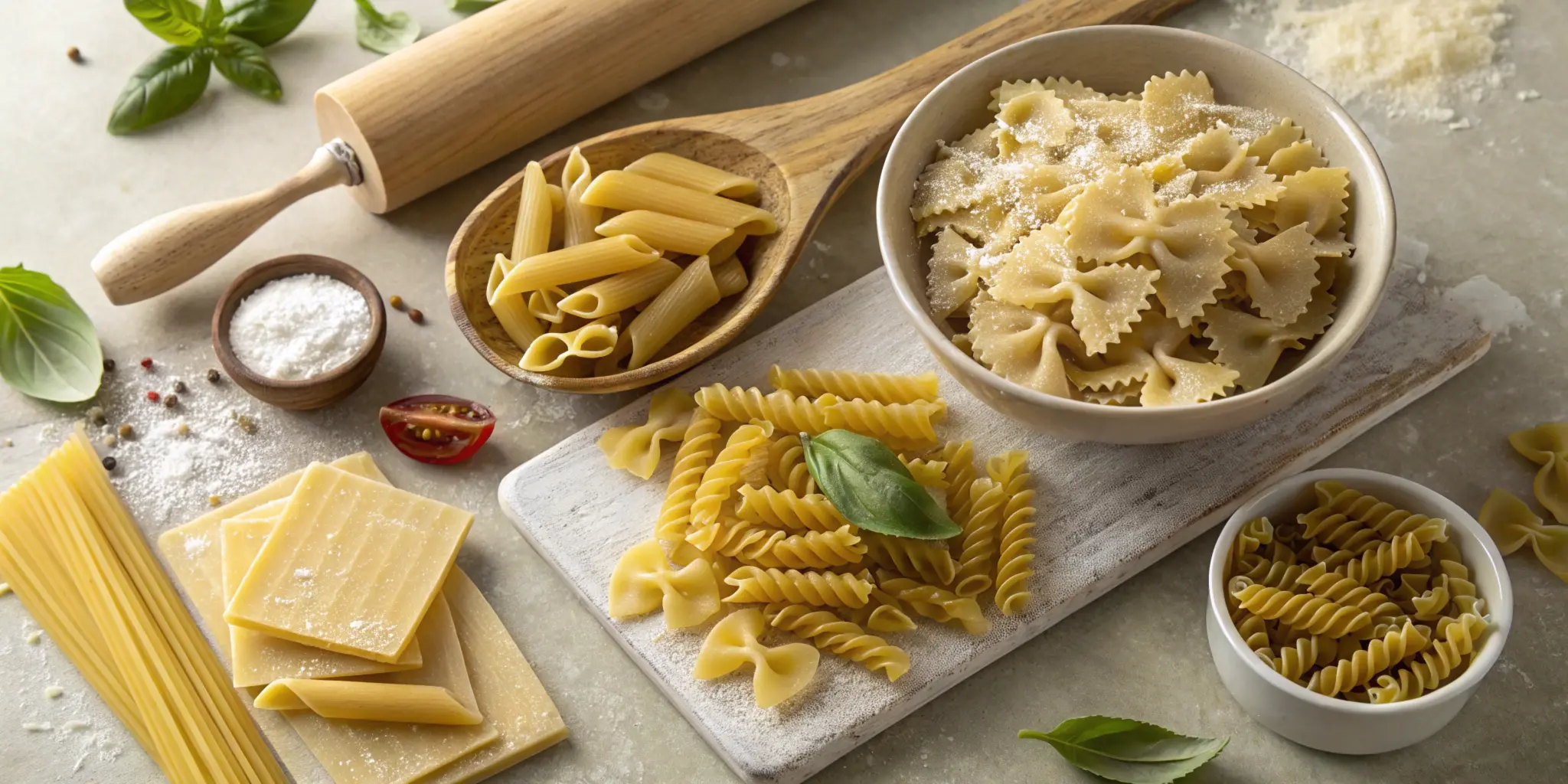When you’re ready to whip up a pasta dish, only to find your pantry missing campanelle pasta, it can be frustrating. This bell-shaped pasta is beloved for its ability to hold sauces beautifully, but rest assured, there are excellent alternatives out there. This guide will walk you through the top substitutes for campanelle pasta, ensuring that you can recreate your favorite dishes without missing a beat. From choosing replacements based on sauce compatibility to understanding texture and shape, we’ll cover all the angles to help you make the perfect pick. Let’s dig into the world of pasta alternatives!
Understanding Campanelle Pasta
Origin and Characteristics
Campanelle pasta, also known as “bellflower” pasta, gets its name from the Italian word for “little bells.” Its distinct shape—a rolled, hollow cone with ruffled edges—makes it ideal for holding thick, hearty sauces. Popular in Italian cuisine, campanelle is a favorite for baked dishes, creamy Alfredo sauces, and even simple olive oil-based recipes.
The shape isn’t just for show, though. The unique design traps ingredients like cheese, meat, and vegetables, creating an explosion of flavor with every bite. Its medium thickness and versatility make it a staple in many households.
For a full guide to campanelle pasta, including its history, popular recipes, and expert cooking tips, check out our complete guide here: Campanelle Pasta: A Complete Guide to History, Recipes, and Cooking Tips.
Culinary Uses
Campanelle isn’t just another pasta. It’s often used in dishes where texture and sauce retention matter most. Think rich tomato-based sauces, thick cheese mixes, or even light oil-based dressings. It also shines in pasta salads, baked casseroles, and one-pot meals. The hollow structure ensures every forkful is packed with flavor, while the ruffled edges add a delightful chew.

Why Seek Substitutes for Campanelle Pasta?
Sometimes, you might need a campanelle pasta replacement for reasons beyond your control. Whether it’s due to unavailability or dietary preferences, having reliable campanelle pasta substitutes can make all the difference in saving your recipe.
Availability Issues with Campanelle Pasta
Finding campanelle pasta options in stores can feel like searching for a needle in a haystack. Specialty pasta shapes like campanelle aren’t always stocked in smaller grocery stores or during supply shortages. In such cases, knowing the best pasta alternatives saves you from abandoning your meal plans or making a last-minute grocery run.
Whether you’re preparing a quick pasta salad or a baked dish, being prepared with a good substitute for campanelle ensures you stay on track without compromising on taste or presentation.
Dietary Preferences and Campanelle Pasta Substitutes
For those who follow a gluten-free diet, there are excellent campanelle pasta substitutes made from chickpea, lentil, or rice flour. These options not only mimic the texture of traditional pasta but also add a nutritional boost. For more insights into gluten-free diets and their benefits, check out this comprehensive guide on gluten-free eating.
Additionally, for those watching their carb intake, non-pasta replacements like spiralized zucchini or spaghetti squash provide excellent substitutes. With so many versatile campanelle pasta options, everyone can find a replacement that suits their dietary requirements without compromising on flavor or texture.
Best Substitutes for Campanelle Pasta
When you’re in a pinch and can’t find campanelle pasta, don’t worry—there are plenty of great alternatives that mimic its ability to hold sauces and add texture to your dishes. Below, we explore the best substitutes, each with its unique charm and culinary use.

| Pasta Substitute | Best For | Key Features |
|---|---|---|
| Fusilli | Creamy or light sauces, pasta salads | Spiral shape traps sauce effectively |
| Cavatappi | Thick or cheesy sauces, baked dishes | Corkscrew design holds flavor well |
| Conchiglie (Shells) | Chunky sauces, soups, and casseroles | Scoop-like structure for sauce retention |
| Orecchiette | Oil-based sauces, sautéed vegetables | Small bowl shape for holding ingredients |
| Penne | Hearty tomato or Alfredo sauces | Tubular structure for versatile use |
| Rigatoni | Meat-based or chunky vegetable sauces | Ridged surface clings to sauces |
| Farfalle (Bow-Tie) | Pasta salads, light and creamy sauces | Wide, flat design for delicate textures |
| Rotini | Cheesy casseroles, vibrant pasta salads | Tight spirals for even sauce distribution |
| Manicotti | Baked dishes with fillings like ricotta | Large tube for stuffing |
| Cannelloni | Stuffed baked pasta dishes | Hollow structure ideal for rich fillings |
Fusilli
Fusilli, the spiraled pasta, is an excellent replacement for campanelle due to its ability to trap sauces within its curls. Its tight spirals cling to both light and thick sauces, making it perfect for creamy Alfredo or robust Bolognese dishes.
Additionally, fusilli works wonders in cold pasta salads. Its sturdy structure holds up well during mixing, ensuring even distribution of dressings and add-ins like vegetables or cheese. Whether baked or tossed in a skillet, fusilli steps in as a reliable and delicious substitute.
Cavatappi
Cavatappi, or “corkscrew” pasta, is a playful and versatile alternative to campanelle. Its hollow and twisted shape captures sauces effortlessly, making it a fantastic choice for hearty meals. Think mac and cheese, casseroles, or creamy vodka sauces—cavatappi does it all.
This pasta’s quirky shape adds visual appeal to your plate, and its slightly thicker texture ensures it stays al dente longer. For dishes requiring pasta with a bold presence, cavatappi rises to the occasion.
Conchiglie (Shells)
If there’s one pasta that’s universally loved, it’s conchiglie, or “shells.” Their cup-like form makes them a fantastic stand-in for campanelle. Small shells are perfect for lighter dishes like soups or broths, while larger shells excel in stuffed recipes.
Conchiglie pairs well with meat sauces, creamy ricottas, or simple garlic butter. Thanks to their scooping ability, they’re great for family-friendly meals where every bite feels indulgent.
Orecchiette
Translated as “little ears,” orecchiette is another substitute worth considering. Its small, concave shape acts like a tiny bowl, perfectly suited for holding chunkier sauces, meat, and vegetables.
Orecchiette is particularly popular in Mediterranean dishes, often paired with sautéed greens or tangy tomatoes. Its compact size also makes it a delightful addition to soups and stews, giving dishes a hearty, satisfying texture.
Penne
Penne, with its tubular shape and diagonal ends, is one of the most accessible substitutes for campanelle. Available in smooth or ridged varieties, penne holds sauce like a pro, particularly when working with cream or tomato bases.
Because of its firm structure, penne is ideal for baked pasta dishes like casseroles. Its widely available, easy-to-cook nature makes it a go-to option when campanelle isn’t an option.
Rigatoni
Rigatoni, larger and wider than penne, boasts ridges that make it a sauce lover’s dream. This pasta is perfect for hearty, chunky sauces, such as ragù or sausage-based recipes.
Its large size also works well in baked dishes where you need something robust. Rigatoni delivers a chewy, satisfying texture that holds its own even in the most sauce-heavy meals.
Farfalle (Bow-Tie Pasta)
Farfalle, affectionately known as bow-tie pasta, is a visually appealing substitute for campanelle. Its wide, flat shape with pinched centers offers a slightly different texture but works well with creamy or pesto sauces.
Farfalle is particularly popular in pasta salads due to its bite-sized appeal. It’s also an excellent choice for kids’ meals, thanks to its whimsical shape. Whether cold or hot, farfalle holds up beautifully.
Rotini
Rotini’s tightly wound spirals make it another excellent alternative to campanelle. Like fusilli, its grooves cling to sauces, ensuring maximum flavor in every bite.
Rotini is particularly well-suited for cheesy casseroles or vibrant pasta salads. Its springy texture and compact size make it a crowd-pleaser in almost any dish, from light summer recipes to hearty winter meals.
Manicotti
For baked dishes, manicotti offers a unique twist as a campanelle substitute. These large, hollow tubes are traditionally stuffed with cheese or meat before being baked in marinara or Alfredo sauce.
Manicotti’s size makes it ideal for dishes that require a filling, though it might not work as well in quick, stir-together recipes. Still, its ability to hold and complement rich flavors makes it a worthy consideration.
Cannelloni
Cannelloni is another tubular pasta that shines in stuffed and baked recipes. Similar to manicotti, its hollow center is perfect for holding fillings like ricotta, spinach, or ground meat.
Although less common in some households, cannelloni offers a hearty texture that mimics campanelle’s versatility. For meals where presentation matters, cannelloni can steal the show with its structured, elegant look.
Factors to Consider When Choosing a Substitute
When it comes to finding the best substitute for campanelle pasta, the choice isn’t just about what’s available. Selecting the right alternative depends on several factors that can make or break your dish. Whether you’re dealing with a hearty sauce, a delicate preparation, or an artistic presentation, knowing what to look for is key. Let’s dive into the main considerations.
Sauce Compatibility
One of the first things to think about is how your pasta pairs with the sauce. Campanelle pasta is prized for holding thicker sauces due to its bell shape and ruffled edges. When selecting a substitute, consider the type of sauce you’re using:
- Chunky sauces: Pasta with ridges or hollows, like rigatoni or cavatappi, works best because they cling to the sauce well.
- Light sauces: For olive oil-based or light cream sauces, smaller or flatter pasta like farfalle or orecchiette might be a better choice.
- Baked dishes: Tubular options like manicotti or cannelloni hold heavy, baked sauces beautifully, making them ideal for casseroles.
Matching your substitute to the sauce ensures that every bite feels balanced and flavorful.
Cooking Methods
The cooking method can significantly influence your choice of substitute. Some pasta shapes excel in boiling, while others are better suited for baking or pan-frying.
- Quick meals: If you’re whipping up a fast stir-together dish, opt for smaller pasta like penne or rotini. They cook quickly and mix well with other ingredients.
- Baked dishes: Sturdier shapes like rigatoni or shells hold up under the heat and don’t fall apart.
- One-pot dishes: Choose a substitute like fusilli that evenly cooks with the other components of your meal.
Paying attention to your cooking method ensures your dish maintains its intended texture and integrity.
Texture and Shape
The texture and shape of your pasta play a crucial role in the dining experience. While campanelle is known for its unique structure, substitutes can replicate or even add to the texture in different ways.
- Chewy textures: Larger pasta like cannelloni or rigatoni provides a satisfying chew, mimicking campanelle’s thickness.
- Creative shapes: If presentation is a priority, farfalle or orecchiette can add a playful touch to your plate.
- Versatility: Spiraled shapes like fusilli or rotini bring both texture and practicality, making them a favorite for family meals.
By aligning your choice of substitute with the desired texture and shape, you can ensure the dish feels authentic, even without campanelle.
Cooking Tips for Pasta Substitutes
Using a substitute for campanelle pasta doesn’t just stop at choosing the right shape. Cooking it correctly is equally important to achieving a delicious dish. From boiling techniques to serving ideas, these tips will ensure that your pasta substitutes shine just as brightly as the original.
Boiling Techniques
Boiling pasta might seem straightforward, but a few adjustments can make a big difference when cooking substitutes for campanelle. Here are some key tips:
- Use Enough Water: Pasta needs room to move while boiling. Use at least 4 quarts of water for every pound of pasta to prevent sticking.
- Salt the Water Generously: Pasta absorbs salt as it cooks, enhancing its flavor. Add about a tablespoon of salt per gallon of water for optimal taste.
- Stir Often: Some substitutes, like fusilli or rotini, can tangle or stick together. Stirring every few minutes helps keep them separate.
- Follow Package Instructions: Different shapes cook at different rates. Check the recommended cooking time and start testing a minute before the lowest time to achieve al dente perfection.
- Save the Pasta Water: This starchy water is liquid gold! Use it to adjust the consistency of your sauce, making it creamier and helping it stick to the pasta.
Proper boiling ensures that your pasta substitute holds its shape and texture, complementing your dish beautifully.

Serving Suggestions
Once your pasta is cooked, it’s time to think about how best to serve it. The way you plate and pair your pasta substitute can elevate your dish’s flavor and presentation:
- Pair the Right Sauce: Thick sauces pair well with pasta like rigatoni or shells, while light, oil-based sauces work wonders with options like farfalle or orecchiette.
- Toss, Don’t Pour: Instead of ladling sauce on top, toss the pasta with the sauce in a skillet for even coating. This technique ensures every bite is flavorful.
- Garnish for Impact: A sprinkle of parmesan cheese, a handful of fresh basil leaves, or a drizzle of olive oil can make all the difference in both flavor and appearance.
- Serve Warm: Pasta is best enjoyed hot or warm. If serving later, toss it in a bit of oil to prevent clumping.
- Side Dishes Matter: Balance your meal with sides like garlic bread, a crisp green salad, or roasted vegetables.
With these tips, your pasta substitute will seamlessly blend into any recipe, delivering the same satisfaction as campanelle.
Frequently Asked Questions
What is the closest substitute for campanelle pasta?
The closest substitute for campanelle pasta would be cavatappi or conchiglie (shells). Both of these shapes share campanelle’s ability to hold sauces and ingredients exceptionally well. Cavatappi’s hollow, spiral design makes it ideal for creamy or chunky sauces, while conchiglie’s shell-like structure scoops up sauce perfectly.
Other great alternatives include fusilli, for its spiraled grooves, and orecchiette, which mimics campanelle’s small bowl-like effect. The best choice depends on your dish, but these substitutes will keep the flavors intact.
Can I use macaroni as a substitute for campanelle?
Yes, macaroni can work as a substitute for campanelle, but with a few caveats. Macaroni’s small, tubular shape lacks the ruffled edges and hollow depth of campanelle, which means it might not hold chunkier sauces as effectively.
However, macaroni shines in dishes with creamy or cheesy sauces, such as mac and cheese or light casseroles. While it may not provide the same visual appeal or texture, it’s a reliable option in a pinch, especially for quick and simple meals.
Which pasta holds sauce the best?
When it comes to retaining sauce, pasta with ridges or hollows performs the best. Options like rigatoni, penne rigate, and cavatappi excel at clinging to sauces, thanks to their textured surfaces and tubular shapes.
Campanelle, with its ruffled edges and conical hollow, is particularly well-suited for thick or chunky sauces. Among substitutes, shells (conchiglie) and rotini also do a great job of trapping both light and heavy sauces, ensuring every bite is packed with flavor.
How to cook campanelle pasta?
Cooking campanelle pasta is simple. Bring a large pot of salted water to a rolling boil, then add the pasta. Stir occasionally to prevent sticking and cook for 10–12 minutes, or until al dente. Drain and toss with your favorite sauce.
What is campanelle pasta?
Campanelle pasta, which translates to “little bells” in Italian, is a cone-shaped pasta with ruffled edges. It’s known for its ability to hold sauces and is popular in Italian cooking.
To learn more about campanelle pasta, including its history, culinary uses, and expert tips, check out our comprehensive guide here: What Is Campanelle Pasta? History, Uses, and Tips.
How long to cook fresh campanelle pasta?
Fresh campanelle pasta cooks faster than dried. It typically takes about 2–3 minutes in boiling water. Always check for an al dente texture.
For a detailed breakdown of how long to cook fresh campanelle pasta, including step-by-step instructions and helpful tips, check out our complete guide here: How Long to Cook Fresh Campanelle Pasta.
What is the difference between gigli and campanelle?
While both gigli and campanelle are similar in shape, gigli is slightly smaller and has a more pronounced cone with tighter ruffles. Both are great for holding sauces, but campanelle has a larger capacity, making it more versatile for chunkier sauces or fillings.
If you’re curious about the differences between gigli and campanelle pasta, including their unique uses and best cooking tips, explore our in-depth comparison here: Gigli vs. Campanelle: Key Differences, Uses, and Tips.
Conclusion
Finding the perfect substitute for campanelle pasta doesn’t have to be a challenge. With so many excellent alternatives available, you can confidently recreate your favorite recipes without sacrificing flavor or texture. From spiraled fusilli to tubular rigatoni and versatile shells, each substitute for campanelle pasta offers unique qualities that can suit various sauces, cooking methods, and presentation styles.
When choosing a substitute for campanelle pasta, consider the sauce compatibility, cooking method, and desired texture. For creamy or chunky sauces, options like cavatappi, conchiglie, or rigatoni are great picks. Meanwhile, for lighter, oil-based dishes, farfalle or orecchiette can shine. Always cook your pasta substitutes thoughtfully, ensuring they achieve the right consistency to complement your dish.
Whether you’re tackling a hearty casserole, a quick pasta salad, or a comforting bowl of creamy pasta, knowing how to adapt with a substitute for campanelle pasta ensures that every meal is a success. With the tips and alternatives shared in this guide, you’ll never miss out on a delicious pasta dish—even without campanelle in your pantry.

